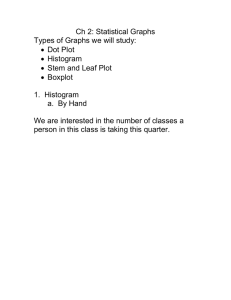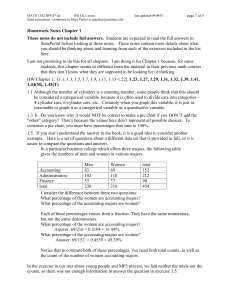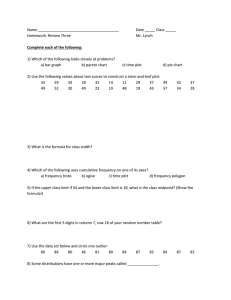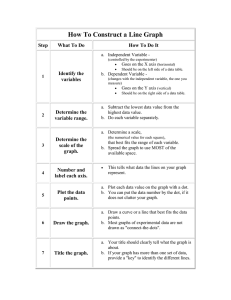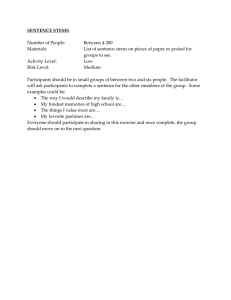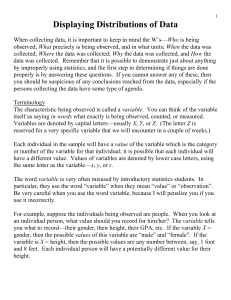MATH 1342 BPS 5
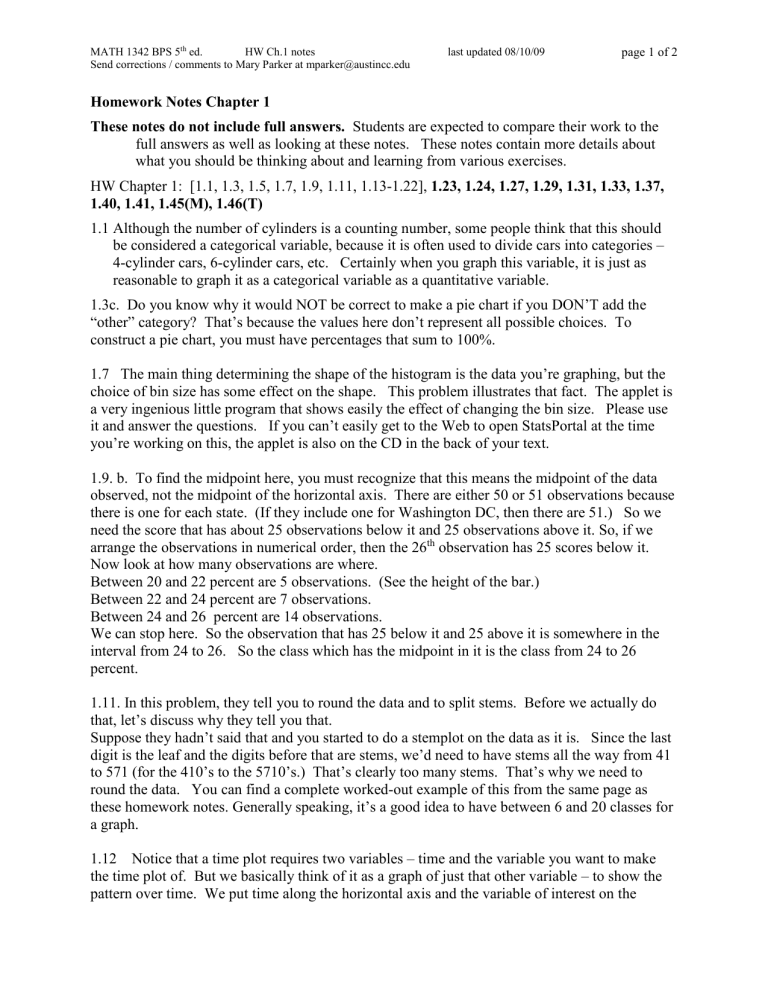
MATH 1342 BPS 5 th ed. HW Ch.1 notes last updated 08/10/09
Send corrections / comments to Mary Parker at mparker@austincc.edu page 1 of 2
Homework Notes Chapter 1
These notes do not include full answers. Students are expected to compare their work to the full answers as well as looking at these notes. These notes contain more details about what you should be thinking about and learning from various exercises.
HW Chapter 1: [1.1, 1.3, 1.5, 1.7, 1.9, 1.11, 1.13-1.22], 1.23, 1.24, 1.27, 1.29, 1.31, 1.33, 1.37,
1.40, 1.41, 1.45(M), 1.46(T)
1.1
Although the number of cylinders is a counting number, some people think that this should be considered a categorical variable, because it is often used to divide cars into categories –
4-cylinder cars, 6-cylinder cars, etc. Certainly when you graph this variable, it is just as reasonable to graph it as a categorical variable as a quantitative variable.
1.3c. Do you know why it would NOT be correct to make a pie chart if you DON’T add the
“other” category? That’s because the values here don’t represent all possible choices. To construct a pie chart, you must have percentages that sum to 100%.
1.7 The main thing determining the shape of the histogram is the data you’re graphing, but the choice of bin size has some effect on the shape. This problem illustrates that fact. The applet is a very ingenious little program that shows easily the effect of changing the bin size. Please use it and answer the questions. If you can’t easily get to the Web to open StatsPortal at the time you’re working on this, the applet is also on the CD in the back of your text.
1.9. b. To find the midpoint here, you must recognize that this means the midpoint of the data observed, not the midpoint of the horizontal axis. There are either 50 or 51 observations because there is one for each state. (If they include one for Washington DC, then there are 51.) So we need the score that has about 25 observations below it and 25 observations above it. So, if we arrange the observations in numerical order, then the 26 th
observation has 25 scores below it.
Now look at how many observations are where.
Between 20 and 22 percent are 5 observations. (See the height of the bar.)
Between 22 and 24 percent are 7 observations.
Between 24 and 26 percent are 14 observations.
We can stop here. So the observation that has 25 below it and 25 above it is somewhere in the interval from 24 to 26. So the class which has the midpoint in it is the class from 24 to 26 percent.
1.11. In this problem, they tell you to round the data and to split stems. Before we actually do that, let’s discuss why they tell you that.
Suppose they hadn’t said that and you started to do a stemplot on the data as it is. Since the last digit is the leaf and the digits before that are stems, we’d need to have stems all the way from 41 to 571 (for the 410’s to the 5710’s.) That’s clearly too many stems. That’s why we need to round the data. You can find a complete worked-out example of this from the same page as these homework notes. Generally speaking, it’s a good idea to have between 6 and 20 classes for a graph.
1.12 Notice that a time plot requires two variables – time and the variable you want to make the time plot of. But we basically think of it as a graph of just that other variable – to show the pattern over time. We put time along the horizontal axis and the variable of interest on the
MATH 1342 BPS 5 th ed. HW Ch.1 notes last updated 08/10/09
Send corrections / comments to Mary Parker at mparker@austincc.edu page 2 of 2 vertical axis. That’s different from every other graph in this chapter, where the values of the variable of interest go along the horizontal axis.
Typically you will want to connect the points to make it easier to see any pattern that is there.
It’s pretty easy to make a time plot by hand. Instructions are provided on the same page from which you found these homework notes for making timeplots using software.
1.33. Notice that it is pretty easy to determine that numbers 1 and 2 must go with graphs b and c.
Graph b illustrates a situation where one of the options is very much more prevalent than the other. Is it clear to you which of 1 and 2 that must be? So numbers 3 and 4 must go with graphs a and d. So notice that graph a is very skewed to the right. Which of numbers 3 and 4 is more likely to have a strongly skewed distribution?
1.40. When comparing data using graphs, tables, or other statistical summaries, you must always think about carefully about whether the summaries you choose are reflecting enough of the reality to give an accurate picture of the situation. That common-sense approach may help you make choices in situations like this one. More information and examples are provided on the
Homework Notes website about “Choosing Counts or Percentages.”
1.45. Postpone working on this problem until you have done your Orientation to Minitab and gotten started on it. For most students, that will be during or after Chapter 2. But then be sure to come back and do this problem.
The main point of this problem is for you to see that you can look at the same data in more than one way and different types of graphs are appropriate depending on what way you want to look at the data.
For part a, if you want to describe the shape, center, and spread of a distribution, then a histogram is useful. (A stemplot with appropriately split stems could also have been used, but they didn’t ask for that.)
For part b, if you want to see whether there is a trend in the values over time, a histogram is not helpful at all but a time plot is very useful.
When students are just getting used to time plots, they tend to focus on the fact that there is a lot of up-and-down movement and think that is cycles, and don’t pay attention to the fact that the overall trend of the graph is going upward. But the up and down movement here isn’t really cycles. They aren’t very regular and they don’t last over several years mostly – it is just that, quite often, there is quite a lot of difference in the number of attacks from one year to another.
1.46 Some students ask whether they are really just being asked their preference here and any answer is OK. Yes, you are being asked your preference. But you are supposed to think of yourself in the role of a person who is trying to explain to someone else what information the data provides. Since you are giving a stemplot, that means you think that the shape, center, and/or spread of the distribution is important. So which of these stemplots do you think best conveys that information and why?

